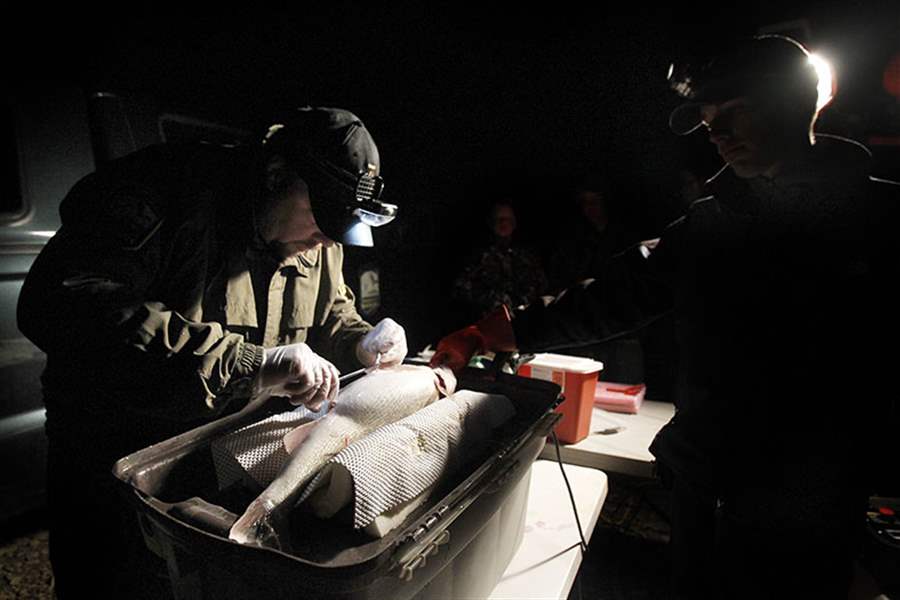
OUTDOORS
Lake Erie walleyes giving up their secrets one ping at a time
5/2/2014
Biologist Chris Vandergoot inserts a tracking tag in a walleye in 2012. Scientists are now studying the data.
The Blade/Lori King
Buy This Image

As Chris Vandergoot lowered a portable receiver into the water above one of western Lake Erie’s many reefs, he listened intently through his headphones as the sophisticated electronics searched the depths for that reassuring tone.
It comes quickly. That distinct “ping, ping, ping” is the sound of success.
“It’s wow, they’re back,” Vandergoot said this week, repeating his reaction when some of the walleyes he had surgically implanted acoustic transmitters in months or years earlier, had returned to the reef.
What we know about the greatest treasure trove of walleyes in the world that make Lake Erie home, is that we actually don’t know a whole lot about them. But Vandergoot, and a multinational lineup of biologists from Ohio, Michigan, Pennsylvania, New York, and Ontario are working to change that, armed with some clever pieces of technology.
Fish are captured at various sites, usually through electrofishing, and anesthetized while a quick surgical procedure inserts an acoustic transmitter into their belly area. A few sutures close the opening, some Betadine is applied to the area to ward off infection, and after a short recovery period the fish is back in the water and ready to transmit data and start shedding some light on its travels, its habitat preferences, its favorite water temperatures, and much, much more.
The program is called GLATOS, and that is not a Greek god you forgot about from mythology class. GLATOS is in that pea soup of acronyms that are part and parcel of the intensive study of the lakes, and it stands for Great Lakes Acoustic Telemetry Observation System.
There is a network of receivers spread throughout the Great Lakes, and each time one of the several hundred walleyes carrying a transmitter is within range, the receiver picks up a ping that is distinct to that particular fish.
The receivers form a picket line across the western end of the lake, in a single strand from Point Pelee to the north end of Pelee Island, and in multiple strands from the south end of Pelee Island to Kelleys Island, and from Kelleys to the mainland. There are also receivers in the Central Basin, and at Rondeau Bay on the Ontario shoreline, and in the Maumee River.
The fixed receivers are anchored to the lake bottom, where they store information on when a ping from a certain fish was received, and what conditions were present at the time. The study is in its very early stages, but when those receivers are retrieved and brought back to the Ohio Division of Wildlife Sandusky Fisheries Research Station where he works, Vandergoot is bouncing off the walls to get at the data.
“It is exciting. They almost have to restrain me, because when I get that receiver in my hand, I want to run to download the information into the computer,” he said.
Earlier studies that involved just external tags could only tell biologists that a fish had traveled from point A to point B, but the mysteries and the mother lode of information involve what takes place throughout the walleyes’ movement.
The GLATOS study should give biologists a much better grasp of migration rates and routes, which particular stocks of fish contribute the most to the Lake Erie harvest, and provide a better understanding of the spawning patterns and preferences of the lake’s walleyes.
“We're taking the needle out of the haystack,” Vandergoot said.
The first snippets of data have been eye-opening. About five percent of the walleyes that took on transmitters in the Maumee River or out on Lake Erie ended up migrating up the Detroit River, with some moving all the way across Lake St. Clair, up the St. Clair River, and into Lake Huron.
One walleye showed up near Conneaut, some 140 miles from where it had been tagged, while another walleye that was given a transmitter during the spawning run in the Maumee River in 2011 was later detected near Port Colborne in Ontario, in the extreme eastern end of Lake Erie.
“It’s a little surprising,” Vandergoot said. “There’s a lot more mid-lake movement than we thought, and certain fish are moving significant distances. This program is giving us insight into the behavior of these fish that we never would have had otherwise.”
The fish that carry the transmitters, which have a battery life of five years, are also marked with a bright orange fin tag that alerts an angler that catches the fish to a $100 reward for returning the transmitter.
“Anytime we do something like this, it’s a bit of a gamble,” Vandergoot said about the walleye tracking program.
“There are some reservations when we put new technology in place, but the fact that this is actually working, and we get the receivers back and download the data — it’s holy cow, this is working.”
Vandergoot stressed that the tip of the iceberg is all that has been seen to this point, but as more receivers are collected and their data used to broaden our understanding of this precious resource, we will know more about Lake Erie walleyes that we ever have before.
“Just tagging fish is cool and it makes for some great pictures, but getting the data back ... for scientists, that’s incredibly exciting. That’s what gets us up in the morning,” he said.
Contact Blade outdoors editor Matt Markey at: mmarkey@theblade.com or 419-724-6068.